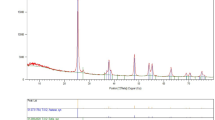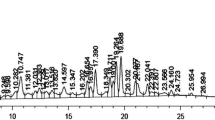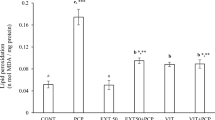Abstract
The antioxidant efficacy of vitamin E on Perchloroethylene (PER) induced cytotoxicity has been studied in rats. Feeding PER to rats for 42 days using sesame oil as vehicle alters total protein and protein bound carbohydrate components in liver and kidney of experimental animals. Supplementation of vitamin E prevented the changes observed in total protein and protein bound carbohydrate components of PER administered rats. Histopathological studies also show the effectiveness of vitamin E on PER administered rats in protecting the cellular architecture of liver and kidney from PER induced cytotoxicity.
Similar content being viewed by others
References
Plaa G: Toxic responses of the liver. In: J. Doull, C.D. Klassen and M.O. Amdur (eds). Toxicology. Macmillan, New York, 1980, pp 206–231
Kyrklund T, Kjellstrand P, Haglid K: Lipid composition and fatty acid pattern of the gerbil brain after exposure to Perchloroethylene. Arch Toxicol 60: 397–400, 1987
National Cancer Institute: Bioassay of Tetrachloroethylene for possible carcinogenicity. DHEW Publ No (NIH) 1976, pp 77–813
Green T, Odum J, Nash John A, Foster John R: Perchloroethylene induced rat kidney tumors: An investigation of the mechanism involved and their relevance to humans. Toxicol and Applied Pharmacol 103: 77–89, 1990
John A Buben, Ellen J O'Flaherty: Delineation of the role of metabolism in the hepatotoxicity of Trichloroethylene and Perchloroethylene: A-dose-effect study. Toxicol and Applied Pharmacol 78: 105–122, 1985
Bolt HM, Filser JG: Irreversible binding of chlorinated ethylenes to macromolecules. Environ Health Perspect 21: 107–112, 1977
NeuFeld EF, Ashwell G: In: W.J. Lennary (ed). The Biochemistry of Glycoproteins and Proteoglycans. Plenum, New York, 1980, pp 241–266
Hughes RC: Membrane glycoproteins. Butterworth, London, 1976, pp 114–134 and pp 152–170
Glick MC, Momoi M, Santer UV: Biochemical specificities at the cell surface. In: E. Grundmann (ed). Metastatic tumor growth. Cancer campaign 4, 1980, pp 11–19
Cotran RS, Rennke HG: Anionic sites and the mechanisms of Proteinuria. N Engl J Med 309: 1050–1052, 1983
Burton GW, Ingold KO: Autooxidation of biological molecules. The antioxidant activity of vitamin E and related chain breaking phenolic antioxidantsin vitro. J Am Chem Soc 103: 6472–6477, 1981
Diplock AT: The role of vitamin E in biological membranes. In: R. Porter and J. Whelan (eds). Biology of vitamin E. Ciba Foundation Symposium 101: Pitman, London, 1983, p 4
Herber SL, Wessler RW: Effect of vitamin E in carcinogenicity of methylcholantherene. Proc Soc Exp Biol Med 111: p 774, 1962
Lowry OH, Rosenbrough NJ, Farr AL, Randall RJ: Protein determination using Folin-ciocalteau reagent. J Biol Chem 193: 265–275, 1951
Niebes P: Determination of enzymes and degradation products of glycosamino glycan metabolism in the serum of health of varicose subjects. Clin Chim Acta 42: 399–408, 1972
Wagner WD: A more sensitive assay disseminating galactosamine and glucosamine in mixtures. Anal Biochem 94: 394–396, 1979
Warren L: The thiobarbuturic acid assay of sialic acid. J Biol Chem 234: 1971–1975, 1959
Hooper K, Gold LS: Ranking the carcinogenic hazards of occupational exposures. Prog Clin Biol Res 207: 217–228, 1986
Allemand H, Pessayre D, Descatoire V, Degott C, Feldmann G, Benhamorue J: Metabolic activation of trichloroethylene into a chemically reactive metabolic toxic to the liver. J Pharmacol Exp Ther 204: 715–723, 1978
Heidelberger C: Chemical Carcinogenesis. Ann Rev Biochem 44: 79–21, 1975
Laib RJ, Stockle G, Bolt HM, Kunz W: Vinyl chloride and trichloroethylene: comparison of alkylating effects of metabolites and induction of preneoplastic enzyme deficiencies in rat liver. J Cancer Res Clin Oncol 194: 139–147, 1979
Shetlar MR, Erwin CP, Everett MR: Serum Polysaccharide levels in rats bearing the walker 256 tumor. Cancer Res 10: 445–447, 1950
Rachesky MH, Hard GC, Glick MC: Membrane glycopeptides from chemically transformed cells: comparison between mesenchymal and epithelial cell lines derived from dimethyl-nitrosamine-treated rat kidney. Cancer Res 42: 39–43, 1982
Hynes RO: Cell surface proteins and malignant transformation. Biochim Biophys Acta 458: 73–107, 1976
Elcombe CR, Rose MS, Pratt IS: Biochemical histological and ultra structural changes in rat and mouse liver following the administration of trichloroethylene: Possible relevance to species differences in hepatocarcinogenicity. Toxicol and Applied Pharmacol 79: 365–376, 1985
Olden K, Parent JB, White SL: Carbohydrate moieties of glycoproteins — a reevaluation of their functions. Biochem Biophy Acta 650: 209–232, 1982
Patel AB, Venkatakrishna-Bhatt H: Influence of trace metals on serum total sialic acids and perchloric acid-soluble proteins and sialic acids in mice. J Appl Toxicol 9: 67–68, 1989
Srinivasa Rao V, Sirsi M: Serum sialic acid in rats bearing yoshida ascites sarcoma. Indian J Biochem 7: 184–186, 1970
Allalouf D, Gafter U, Malachi T, Hirsh J, Levi J, Levinsky H: Sialic acid and neuraminidase activity in rat kidneys 6 months after uninephrectomy. Bio Chem Med Metabol Biol 39: 182–189, 1988
Bonse G, Urban T, Reichert D, Henschler D: Chemical reactivity, metabolic oxirane formation and biological reactivity of chlorinated ethylenes in the isolated perfused rat liver preparations. Biochem Pharmacol 24: 1829–1834, 1975
Bruner RH: Pathological findings in laboratory animals exposed to hydrocarbon fuels of military interest: In renal effects of Petroleum Hydrocarbon. Princeton Scientific, Princeton, NJ, 1984, pp 133–140
Reitz RH, Watanabe PG, McKenna M, Quast JF, Gehring PJ: Effect of vinylidene chloride on DNA synthesis and DNA repair in the mouse: A comparative study of dimethylnitrosamine. Toxicol Appl Pharmacol 52: 357–370, 1980a
Watanabe PG, Reitz RH, Schumann AM, Mckenna MJ, Quast JF, Gehring PJ: Implications of the mechanism of tumorigenicity for risk assessment. In: The scientific basis of toxicity assessment. H.R. Witschi (ed). New York, vol 6, 1980, pp 69 and 89
Author information
Authors and Affiliations
Rights and permissions
About this article
Cite this article
Ebrahim, A.S., Gopalakrishnan, R., Murugesan, A. et al. In vivo effect of vitamin E on serum and tissue glycoprotein levels in perchloroethylene induced cytotoxicity. Mol Cell Biochem 144, 13–18 (1995). https://doi.org/10.1007/BF00926735
Received:
Accepted:
Issue Date:
DOI: https://doi.org/10.1007/BF00926735




